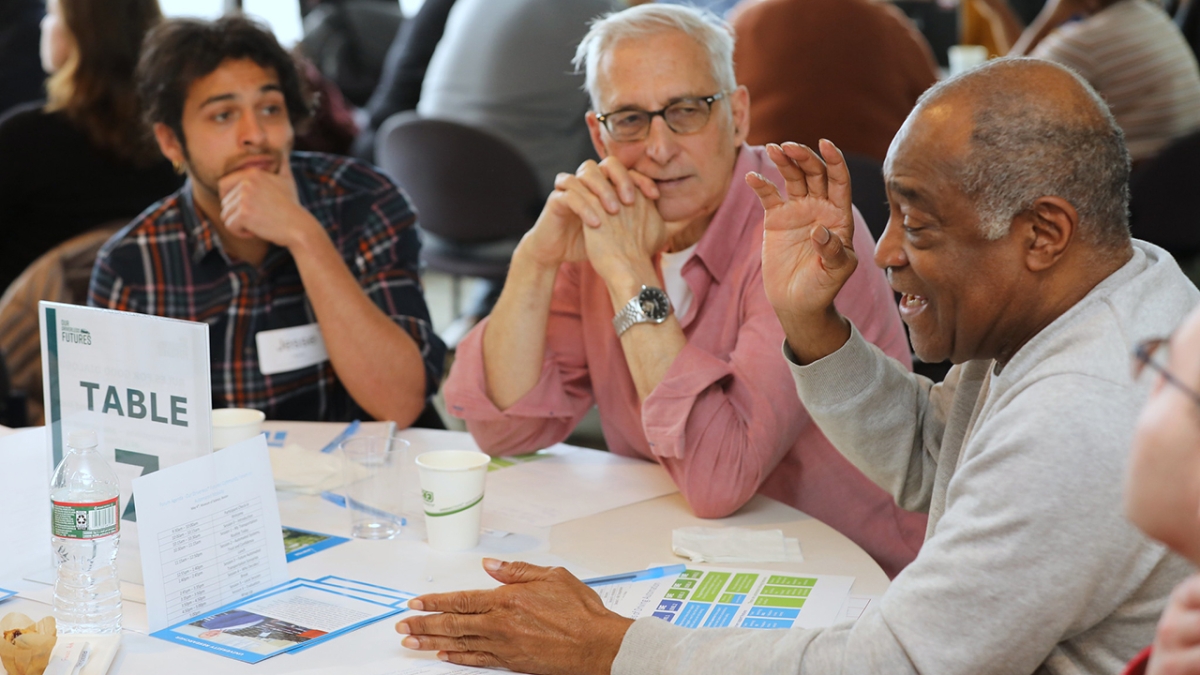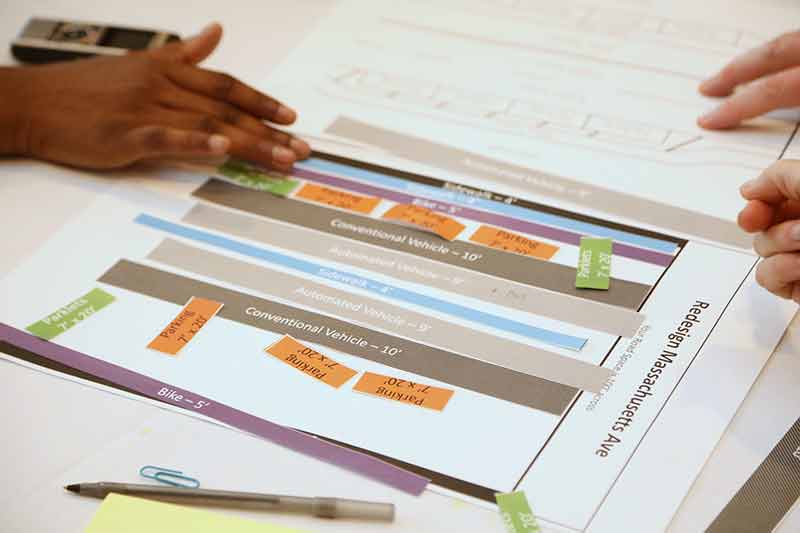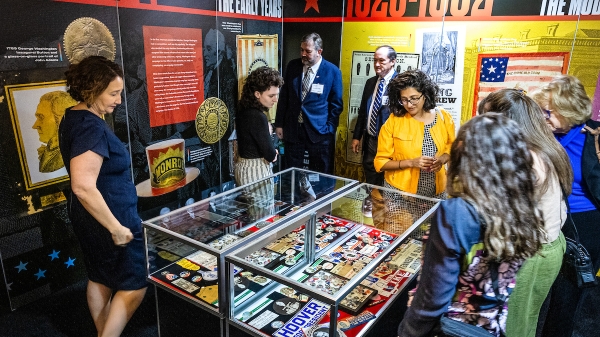Science policy: For the public, by the public

In May 2019, ASU researchers organized a public forum in Boston to discuss driverless cars. Participants gathered at tables to share their perspectives. Photo by Eric Workman/Museum of Science
Along with hard facts and data, science and technology policymakers must also grapple with matters of public value, like concerns about who benefits from science or how safe a new technology is. But often, only a few — experts, interest groups and other highly engaged people — end up providing direct input on these policies.
For more than 10 years, researchers at Arizona State University have been studying a different way of engaging the public — one that gives a voice to those who may not have the resources or awareness to participate in the decision-making process. The start of a new U.S. presidency has given these researchers a chance to highlight the potential of their method.
In a move to emphasize the importance of science to his administration, President Joe Biden announced last month that he is elevating the position of presidential science adviser to Cabinet member. He also wrote a published letter to geneticist Eric Lander — his choice for the role — outlining his administration’s top five science priorities.
One of the president’s stated goals is to “guarantee that the fruits of science and technology are fully shared across America and among all Americans.” In December, the ASU researchers submitted a proposal to the Biden administration based on the success of their team’s work, which they hope will move forward as it aligns well with this particular goal.
The team, in collaboration with the Day One Project, published a policy memo suggesting that the Office of Science and Technology Policy create a special unit to gather information on the public’s values and concerns surrounding new and emerging science and technology. This kind of engagement model is called participatory technology assessment, or pTA. The goal of pTA is to improve the outcomes of science and technology decision-making through dialogue with informed, nonexpert citizens who are generally underrepresented in science and technology policymaking.
“Our work focuses mainly on two questions. Number one is, how can we make science and technology more useful for society? The other is, how can we make science and technology more democratic?” said Mahmud Farooque, who leads the team. Farooque is a clinical associate professor in the School for the Future of Innovation in Society and the associate director for its Washington, D.C., operations. He uses the failed predictions for the success of driverless cars as an example of pTA’s importance.
“If you listened to Elon Musk in 2017, we would have had driverless cars in our streets by now. But there's no driverless cars, because guess what? They didn't stop to think about all the social factors that they have to consider in order to have technological change,” Farooque said.
This focus on engaging the public in science that benefits the public reflects the heart of the Julie Ann Wrigley Global Futures Laboratory, home of the College of Global Futures and its School for the Future of Innovation in Society. The laboratory works to ensure the future habitability of the planet and attainable well-being for all humankind.
The Day One Project, an initiative of the Federation of American Scientists, gives science and technology experts the opportunity to inform agenda-setting by developing innovative policy proposals. Over the last year, it has collected and refined the 100 best science and technology ideas — now published — for action starting on day one of the new presidential term. The project’s leadership council includes former and current federal officials, including Lander, who have worked in the science and technology space and whose influence will help push these ideas forward.
Below, Farooque discusses why public participation in science is important and how pTA can help science agencies with his policy memo co-authors: Michelle Sullivan Govani, director of strategy and partnerships in the ASU Office of Applied Innovation, and Nicholas Weller, postdoctoral research associate in the School for the Future of Innovation in Society.

At a 2019 forum on driverless cars, Farooque and his team asked participants how they would redesign a street to accommodate automated cars, standard cars, pedestrians and bikes. Photo by Eric Workman/Museum of Science
Question: Why should the public be engaged in setting science priorities?
Weller: One good reason to involve more people in that process is you can unearth more ideas about what that public interest might be. You can also provide a counterweight to lobbying and partisan interests. We think that involving more people in those types of decisions helps create more robust systems of governance, more robust science and more robust decision-making processes that actually lead to better outcomes. Making decisions about what research, technologies and scientific endeavors we want to invest in are matters of judgment of what is good, and those are fundamentally public value questions, not necessarily just expert or technical questions.
Sullivan Govani: When you have such complex, multifaceted problems put forth, expanding who has a say and how that problem is approached, or what counts as a solution, is a necessity to ensure that an approach or solution incorporates all that's being asked of it.
Farooque: The saying we usually use is that science informs us, it doesn't tell us what to do. Most of these are value questions — not that science cannot sensibly inform them, but it's for us as a society to decide. And in that way, everybody's an expert. We've been doing science for society, but right now, there are a lot of opportunities with citizen science and community science to do science by and with society. As we are setting the agenda, deciding what to do, people are equal partners in that decision. Then we can avoid going down a path that is not socially acceptable or is destructive and may have a lot of unintended consequences.
Q: How do you find people to participate in these public forums?
Weller: In terms of advertising these, we do everything from ads on Craigslist to handing out flyers in front of a grocery store, reaching out with emails and social media presence, or going to homeless shelters. We try to go to those types of places where you might find people that are otherwise not included in conversations about science and technology policy, meet people where they're at and invite them to participate.
Farooque: We are looking for diversity, not statistical representation, so it's not a public opinion poll. We are trying to get the people who, because of lack of organization or opportunity, are not able to engage. When we are recruiting for these forums, we — and our agency clients and sponsors — are looking for those unheard voices. When we worked with NASA, they wanted to hear from the unusual suspects, they didn't want to hear from the people who are already plugged in. It's not to substitute experts or any organized groups and so forth, but it's to add those missing voices.
We normally hold this thing in a public space, but we started doing it virtually because of COVID-19. We were able to go to places where we are normally not able, so we had a very diverse representation. At the same time, we created new inequities; we were limited to people who have good internet access and technical resources. Post COVID-19, we probably will do some kind of a combination of in-person and online.
Q: How does pTA impact people’s attitudes about science?
Farooque: We see that whenever the public comes into these conversations, their knowledge increases. We do pre- and post-surveys about that subject matter, and though their views do not necessarily change, they do find more common ground solutions. They also are able to find alternative solutions that were not on the table. The other benefit that we do see is not only the public understanding the science, but also science understanding the public — the expert valuing that the public has an important thing to say. There's a change that happens among the experts, stakeholders and decision-makers themselves so that they begin to see the problem in a new light.
Weller: I am doing interviews with policymakers after they come to forums. That's the outcome that I think is important in thinking about trust. Policymakers in interviews say, “I was really impressed by the public's ability to take on this scientific or technical problem, think about all its various facets and make complex decisions.”
Q: How do you ask questions and use the public’s opinions in a way that doesn’t turn science policy decisions into popularity contests?
Farooque: We don't just get their yes and no answers, we also get the why. For instance, there was a question that asked, “If an asteroid is coming, and these are the five options for mitigation, which one would you choose?” And then we asked, “Now the asteroid is coming, but you don't have 20 years to build all this technology, you have five years and three options.” Participants were then choosing the nuclear option, which they didn't choose the first time, and they were torn by that choice. Some wrote a whole essay about how torn they were to make that choice. This helps us to understand the context for that answer, not just what is most popular. When we work with agencies, they actually want to know the stories, rather than the 60% for and 40% against. They're more interested in the values and concerns that people are bringing in. And that gives them a much more robust insight into the problem, to know how things might change if contexts were different.
Weller: Before the public even sees it, there's a back-and-forth development process to make sure that any important information that someone might need to know in order to feel informed and make a decision is included in the forum. And that process can include not just people from the agency client, but also different competing interest groups that might come to the table and want to make sure that the process for creating it isn’t biased.
Q: How do agencies typically use this information?
Farooque: It depends on the context. When we worked with NASA, they were trying to decide between two robotic alternatives about the asteroid redirect mission and understand what public preferences were about those. But then we also asked open-ended questions about the programs themselves. From that, NASA found out people were really concerned that there was no agency entrusted with planetary defense — meaning, if an asteroid was going to come and hit us, who is primarily responsible? When NASA understood that this was a big public concern, they actually established the Planetary Defense Coordination Office. There was always an argument for it, but through this engagement process, they gathered enough evidence that it was something that had great public demand.
In the case of the Department of Energy, they were trying to look at what the process should be for selecting nuclear waste sites so that people feel confident that the department hasn't taken advantage of an underrepresented community. So it depends on what they're trying to understand, and it can answer a specific question or give them a broad understanding of public views.
The challenge is that these studies can’t really be done in the midst of an emergency. If we need to make a decision right now, it’s not easy to organize this whole systemic process. That's why we get involved in a lot of emerging technologies and do a lot of scenarios. For example, if a pandemic were to happen again, how would we respond to the next one learning from this one? If we had already done this kind of engagement, we would have that knowledge to draw from and could have designed a strategy that was in line with getting a better outcome for vaccine hesitancy, distribution and all of these other issues that have come up.
Q: Why did you decide to submit this idea to the Day One Project?
Farooque: Back in 2010, with our partners at the Museum of Science, SciStarter, the Loka Institute and the Wilson Center, we proposed the Expert and Citizen Assessment of Science and Technology (ECAST) network. This group combines the subject matter expertise of universities, the convening power of museums and the policy connections of nonpartisan think tanks to do participatory technology assessment. From 2012 onwards, we started doing projects to demonstrate how it could work. A lot of them have been in partnership with national and global partners. However, right now we can only do this work on a project-by-project basis. We can work with NASA on an asteroid project. We can work with Department of Energy on nuclear waste. We can work with the National Oceanic and Atmospheric Administration on climate change resilience. But those kinds of projects require different negotiations, because the organization is different, what they want is different. That eats up a lot of time. If the federal government were to have the capacity on its own, then it could make it available for all the agencies as they need. Our proposal is to establish that capacity within the federal government so that they can do it at a much broader scale than we do right now.
Sullivan Govani: There's a growing recognition of inequity and lack of inclusion in not only how science and technology investments are designed or priorities decided, but also in how those benefits are distributed once those designs or priorities are carried out. I like to think that the idea of creating more participatory mechanisms in the way that we assess technology priorities and the way that we make decisions about how we're designing our science and technology innovation system can help create that stronger inclusion and equity aspect in how we're sharing the fruits of that labor.
The projects mentioned above were funded by the National Aeronautics and Space Administration, the National Oceanic and Atmospheric Administration, the U.S. Department of Energy, the Kettering Foundation, the Alfred P. Sloan Foundation, the Charles Koch Institute and New Venture Fund.
More Law, journalism and politics

Opportunities and risks of AI in the court system
“Science and innovation have always been an important part of ASU Law.” That's what Stacy Leeds, dean of Arizona State…

Law and addiction: How new science is impacting the justice system
For years, people who struggle with drug addiction have often been considered weak or in need of incarceration by the general…

Exhibit uses rare memorabilia to illustrate evolution of US presidential campaigns
After one of the most contentious elections in history, a new museum exhibit offers a historical perspective on the centuries-old…